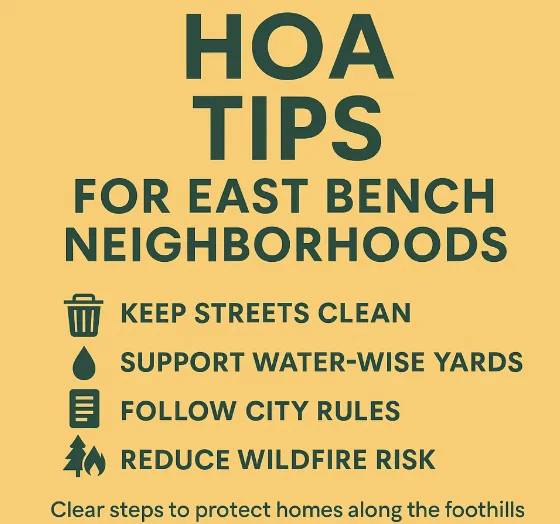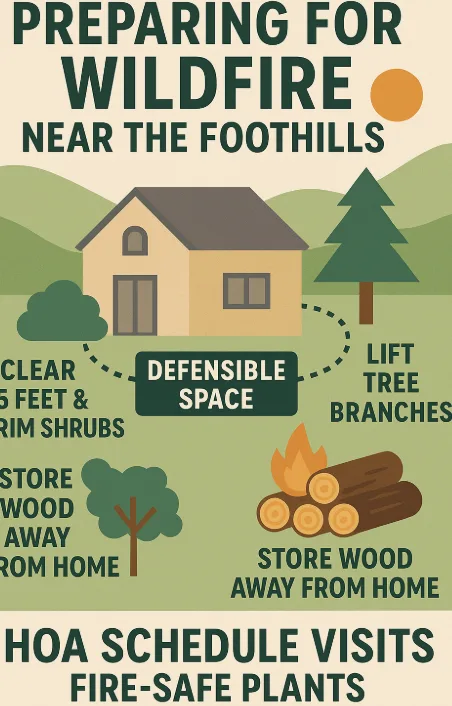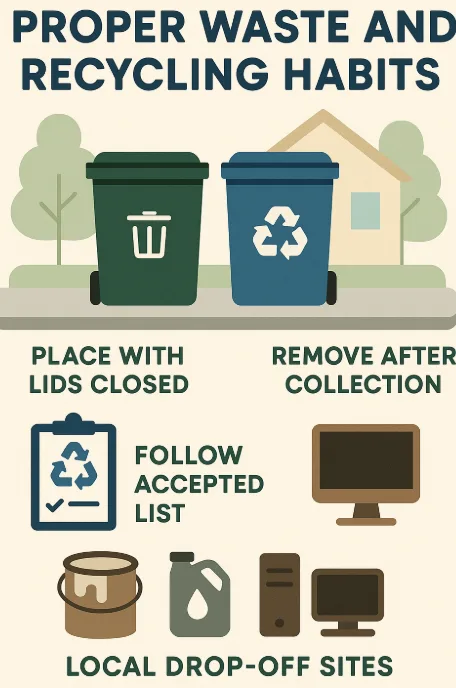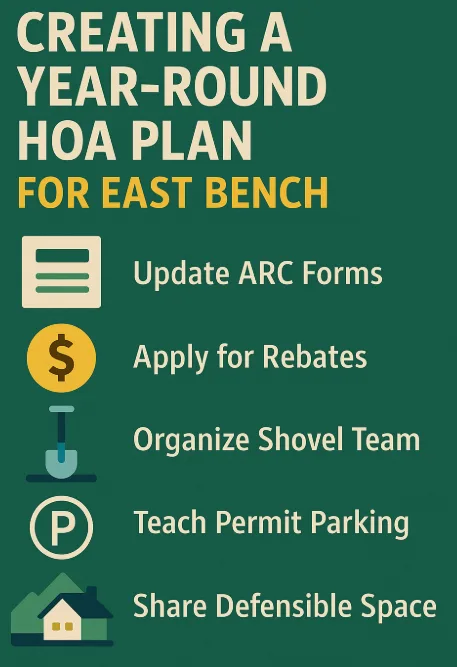HOA Tips for East Bench Neighborhoods
The East Bench sits along the Wasatch foothills. That means sun, slope, wind, and quick storms. A strong HOA plan keeps streets clean, supports water-wise yards, follows city rules, and reduces wildfire risk near the hills. Clear steps protect homes and help property values. A short, simple playbook works best. Share it with owners and link to the city pages you follow.

Why Your HOA Decisions Carry Extra Weight Here
Dry summers raise fire risk. Steep blocks funnel wind. Winter storms reach the Bench faster than lower parts of the city. These conditions shape rules for landscaping, water use, and safety. When your HOA sets standards that match the local setting, neighbors know what to do and why it matters. They also see fair rules that are easy to follow.
A properly sized dumpster helps you keep costs down and finish your cleanout without unnecessary delays.
Preparing for Wildfire Near the Foothills
East Bench homes near the foothills should take wildfire prevention seriously. Creating defensible space by clearing the first five feet around the home, trimming shrubs, and lifting tree branches reduces the risk of ember ignition. Storing firewood and yard waste away from structures adds another layer of safety. HOAs can encourage residents to schedule defensible space visits, where experts provide specific advice for each property. Providing fire safe plant lists also helps homeowners make choices that protect their homes while keeping neighborhoods attractive.

Snow and Ice Rules That Keep Walkways Clear
Snow removal is both a safety and compliance issue in East Bench. Sidewalks and ramps must be cleared within the time limit set after each storm ends. HOAs should remind residents to clear the full width of sidewalks and corner ramps, since children, delivery drivers, and older adults rely on safe passage. Neighborhoods can build volunteer groups to assist those who need help shoveling. A simple list with names and phone numbers can ensure that seniors and residents recovering from illness or surgery receive assistance quickly.
Proper Waste and Recycling Habits
Trash and recycling carts must be placed with lids closed, handles facing the home, and removed from the street soon after collection. Following the city’s accepted recycling list helps reduce contamination and prevents fines. HOAs can share information on local drop-off sites for hard to recycle items such as paint, motor oil, and electronics. Encouraging proper disposal keeps curbs clean, prevents overflow, and supports city sustainability goals.

A Seasonal Checklist for East Bench Neighborhoods
Each season brings different responsibilities for HOAs and residents. In spring, share plant lists that meet city park strip standards and remind residents to apply for turf removal rebates. Summer is the right time to schedule defensible space inspections near the foothills and encourage smart watering habits, such as deep but less frequent watering cycles. In fall, inspect tree branches for sidewalk clearance and remind residents about snow preparation. Winter requires enforcing the 24 hour snow removal rule and keeping a list of volunteers who can help neighbors who are unable to shovel. Seasonal reminders help East Bench neighborhoods stay safe, attractive, and well maintained throughout the year.
Dumpster Sizes for HOA Cleanup Days (Yard Waste and Bulky Items)
Size: | Best Uses For HOA cleanups in East Bench: | Capacity: |
10-yard dumpster | Yard bags, branches, small furniture | 3 pickup loads |
20-yard dumpster | Mixed bulky junk, trimmings, small appliances without refrigerants | 6 pickup loads |
30-yard dumpster | Shared cul-de-sac drop points with couches, shelving, and heavy green waste | 9 pickup loads |
40 yard dumpster | Central staging areas with large amounts of junk and green waste | 12 pickup loads |
For best results, place a yard waste bin near a tree-lined block and a bulky item bin near a wider intersection. Keep liquids, paint, and chemicals out of all dumpsters.
Local Standards You Should Update Now
Park strip standards changed recently. They require more live cover and limit turf and rock. Update your landscaping rules and ARC checklist to match the current page. Rebates expand at times with state funding and most require pre-approval. Put that warning in bold in your next newsletter. Wildfire policy is evolving. The city is moving toward a WUI code. Even now, the fire department supports free home visits. Add the request link to your new-owner packet so people book early.
Common Pitfalls for East Bench HOAs
Some boards still copy old rock-strip rules. Those do not pass under the current standard. Others let snow pile on corners. Ramps must be open within the time window after a storm. A few HOAs skip wildfire reminders. Blocks near the foothills need a fall checklist and a link to defensible space services. Parking is another trouble spot. Teach vendors and guests how permits work so they avoid tickets. Finally, make sure your design rules align with state law. Equal treatment protects owners and the board.
Budget Moves That Stretch HOA Dollars
Small choices add up. Use turf-removal rebates to support water-wise projects. Pool tree purchases and drip parts with nearby HOAs to get better pricing. Share a snow contractor across two or three streets. Host one annual “bulk day” with a short recycling class and a link to city waste pages. Keep fines low and focus on fixes that lift curb appeal first.
HOA Action Guide for Streets and Yards
- Park strips: Require one street tree where width allows. Keep at least one-third live vegetation. Use drip and mulch.
- Rebates: Apply first, then convert turf. Share the current Utah Water Savers steps.
- Wildfire: Clear the first five feet next to the home. Limb up trees. Book a defensible space visit.
- Snow: Shovel sidewalks and ramps within the time window after a storm ends. Create a neighbor help list.
- Parking: Use permit parking where posted. Request a right-of-way permit for work zones that use the street.
- Carts: Follow set-out rules and accepted materials. Add the city waste page to your welcome packet.
FAQs: HOA Tips for East Bench Neighborhoods
How do HOAs handle dumpster placement on narrow or sloped East Bench streets?
Steep hills and tight cul-de-sacs make placement more complex. In most cases, dumpsters should go in driveways with protective pads rather than in the street. If street placement is the only option, the HOA should coordinate with the hauler and confirm city requirements for right-of-way permits to ensure access and safety.
What happens if a homeowner removes turf before getting water rebate approval?
Most rebate programs require an inspection and pre-approval before any turf is pulled. If grass is removed too early, the homeowner risks losing eligibility for the incentive entirely. The HOA can help by reminding residents of these rules in newsletters and requiring proof of pre-approval before allowing turf changes.
How strict are park strip landscaping rules in East Bench, and how do they affect HOAs?
City code requires live vegetation and often a street tree where space allows. Rock-only strips or fully paved areas are no longer compliant. HOAs should incorporate these standards directly into architectural guidelines to avoid confusion. This keeps individual landscaping projects consistent with both city law and HOA enforcement.
When snow falls, who enforces the rules on sidewalk clearing and how quickly must it be done?
Sidewalks and corner ramps must be cleared within the set timeframe after a storm ends, often within 24 hours. Enforcement begins with the city, but HOAs can adopt policies that reinforce the standard and provide neighbor-to-neighbor assistance programs. Volunteer lists help residents who are elderly or recovering from surgery meet the requirement.
Creating a Year-Round HOA Plan for East Bench
Keep your HOA running smoothly with simple, focused steps. Update ARC forms to reflect current landscaping and park strip rules. Remind residents to apply for water-wise rebates before turf removal. Organize a small winter shovel team to keep sidewalks clear. Teach residents how permit parking works and share defensible space resources for homes near the foothills. Keep all reminders short, local, and linked to official city or state pages.

Turning HOA Rules into a Practical Playbook
Residents follow rules more easily when they are clear and accessible. A one-page policy sheet, ready-to-send emails, and a seasonal checklist make communication simple. These tools cut down on confusion and create consistency across the neighborhood.
Book your HOA strategy call for East Bench today and get tailored resources to keep your HOA organized and effective.
